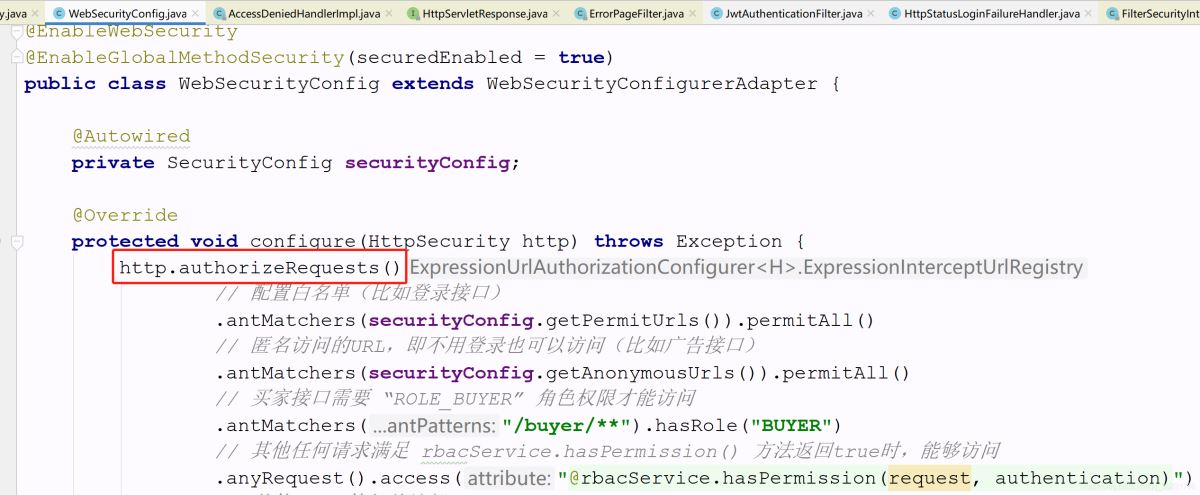Spring Security源码解析之权限访问控制是如何做到的
〇、前文回顾
在实战篇《话说Spring Security权限管理(源码详解)》我们学习了Spring Security强大的访问控制能力,只需要进行寥寥几行的配置就能做到权限的控制,本篇来看看它到底是如何做到的。
一、再聊过滤器链
源码篇中反复提到,请求进来需要经过的是一堆过滤器形成的过滤器链,走完过滤器链未抛出异常则可以继续访问后台接口资源,而最后一个过滤器就是来判断请求是否有权限继续访问后台资源,如果没有则会将拒绝访问的异常往上向异常过滤器抛,异常过滤器会对异常进行翻译,然后响应给客户端。
所以,一般情况下最后一个过滤器是做权限访问控制的核心过滤器FilterSecurityInterceptor ,而倒数第二个是异常翻译过滤器ExceptionTranslationFilter ,将异常进行翻译然后响应给客户端。比如我们实战项目过滤器链图解

二、过滤器的创建
FilterSecurityInterceptor的创建
这个过滤器的配置器是 ExpressionUrlAuthorizationConfigurer ,它的父类 AbstractInterceptUrlConfigurer 中的 configure() 方法创建了这个过滤器。
abstract class AbstractInterceptUrlConfigurer<C extends AbstractInterceptUrlConfigurer<C, H>, H extends HttpSecurityBuilder<H>>
extends AbstractHttpConfigurer<C, H> {
...
@Override
public void configure(H http) throws Exception {
FilterInvocationSecurityMetadataSource metadataSource = createMetadataSource(http);
if (metadataSource == null) {
return;
}
FilterSecurityInterceptor securityInterceptor = createFilterSecurityInterceptor(
http, metadataSource, http.getSharedObject(AuthenticationManager.class));
if (filterSecurityInterceptorOncePerRequest != null) {
securityInterceptor
.setObserveOncePerRequest(filterSecurityInterceptorOncePerRequest);
}
securityInterceptor = postProcess(securityInterceptor);
http.addFilter(securityInterceptor);
http.setSharedObject(FilterSecurityInterceptor.class, securityInterceptor);
}
...
}
这个过滤器的配置器是在 HttpSecurity 的 authorizeRequests() 方法中apply进来的,在我们自己配置的核心配置器中使用的就是该种基于 HttpServletRequest 限制访问的方式。

ExceptionTranslationFilter的创建
这个过滤器的配置器是 ExceptionHandlingConfigurer ,它自己的 configure() 方法中创建了这个过滤器。
public final class ExceptionHandlingConfigurer<H extends HttpSecurityBuilder<H>> extends
AbstractHttpConfigurer<ExceptionHandlingConfigurer<H>, H> {
...
@Override
public void configure(H http) throws Exception {
AuthenticationEntryPoint entryPoint = getAuthenticationEntryPoint(http);
ExceptionTranslationFilter exceptionTranslationFilter = new ExceptionTranslationFilter(
entryPoint, getRequestCache(http));
if (accessDeniedHandler != null) {
exceptionTranslationFilter.setAccessDeniedHandler(accessDeniedHandler);
}
exceptionTranslationFilter = postProcess(exceptionTranslationFilter);
http.addFilter(exceptionTranslationFilter);
}
...
}
这个过滤器的配置器是在 HttpSecurity 的 exceptionHandling() 方法中apply进来的,和上面不同的是,这个过滤器配置器会默认被apply进 HttpSecurity,在 WebSecurityConfigurerAdapter 中的 init() 方法,里面调用了 getHttp() 方法,这里定义了很多默认的过滤器配置,其中就包括当前过滤器配置。

三、源码流程
FilterSecurityInterceptor
- 进入:
doFilter(ServletRequest request, ServletResponse response, FilterChain chain) - 进入:
invoke(FilterInvocation fi) - 进入:
beforeInvocation(Object object)
这个方法里面有个
attributes,里面获取的就是当前request请求所能匹配中的权限Spel表达式,比如这里是hasRole('ROLE_BUYER')
方法源码如下,继续往下走
protected InterceptorStatusToken beforeInvocation(Object object) {
...
// 获取当前request请求所能匹配中的权限Spel表达式
Collection<ConfigAttribute> attributes = this.obtainSecurityMetadataSource()
.getAttributes(object);
...
// Attempt authorization
try {
this.accessDecisionManager.decide(authenticated, object, attributes);
}
catch (AccessDeniedException accessDeniedException) {
publishEvent(new AuthorizationFailureEvent(object, attributes, authenticated,
accessDeniedException));
throw accessDeniedException;
}
...
}
进入:decide(Authentication authentication, Object object, Collection<ConfigAttribute> configAttributes)
这里有个投票器,投票结果为1表示可以访问直接返回,投票结果为-1表示拒绝访问,向上抛拒绝访问异常,这里使用的投票器是
WebExpressionVoter
public void decide(Authentication authentication, Object object,
Collection<ConfigAttribute> configAttributes) throws AccessDeniedException {
int deny = 0;
for (AccessDecisionVoter voter : getDecisionVoters()) {
int result = voter.vote(authentication, object, configAttributes);
if (logger.isDebugEnabled()) {
logger.debug("Voter: " + voter + ", returned: " + result);
}
switch (result) {
case AccessDecisionVoter.ACCESS_GRANTED:
return;
case AccessDecisionVoter.ACCESS_DENIED:
deny++;
break;
default:
break;
}
}
if (deny > 0) {
throw new AccessDeniedException(messages.getMessage(
"AbstractAccessDecisionManager.accessDenied", "Access is denied"));
}
// To get this far, every AccessDecisionVoter abstained
checkAllowIfAllAbstainDecisions();
}
进入:vote(Authentication authentication, FilterInvocation fi, Collection<ConfigAttribute> attributes)
这里面其实就是使用Spring的Spel表达式进行投票,使用请求中的权限表达式组装Expression,使用Token令牌中的权限组装EvaluationContext,然后调用
ExpressionUtils.evaluateAsBoolean(weca.getAuthorizeExpression(), ctx),
public int vote(Authentication authentication, FilterInvocation fi,
Collection<ConfigAttribute> attributes) {
assert authentication != null;
assert fi != null;
assert attributes != null;
WebExpressionConfigAttribute weca = findConfigAttribute(attributes);
if (weca == null) {
return ACCESS_ABSTAIN;
}
EvaluationContext ctx = expressionHandler.createEvaluationContext(authentication,
fi);
ctx = weca.postProcess(ctx, fi);
return ExpressionUtils.evaluateAsBoolean(weca.getAuthorizeExpression(), ctx) ? ACCESS_GRANTED
: ACCESS_DENIED;
}
evaluateAsBoolean()方法里面就是调用Expression的getValue()方法,获取实际的匹配结果,如下图Spel表达式为hasRole('ROLE_BUYER')
所以它实际调用的是SecurityExpressionRoot#hasRole方法(关于权限表达式对应实际调用的方法,在《手把手教你如何使用Spring Security(下):访问控制》文章中已贴出,下面文章也补充一份),里面的逻辑其实就是判断Token令牌中是否包含有ROLE_BUYER的角色,有的话返回true,否则返回false,如下为SecurityExpressionRoot#hasRole方法源码:
private boolean hasAnyAuthorityName(String prefix, String... roles) {
Set<String> roleSet = getAuthoritySet();
for (String role : roles) {
String defaultedRole = getRoleWithDefaultPrefix(prefix, role);
if (roleSet.contains(defaultedRole)) {
return true;
}
}
return false;
}
- 如果投票成功,则会一直返回到
invoke()方法,再执行后续过滤器,未抛异常表示该请求已经有访问权限了 - 假如投票失败,在
decide()方法中会向上抛拒绝访问异常,一直往上抛直到被处理,往上反向跟踪发现这个过滤器一直没有处理拒绝访问异常,那就继续往上个过滤器抛,就到了我们的异常翻译过滤器ExceptionTranslationFilter。
ExceptionTranslationFilter
该过滤器的 doFilter() 方法很简单,没有逻辑处理,只对后续过滤器抛出的异常进行处理,源码如下:
public void doFilter(ServletRequest req, ServletResponse res, FilterChain chain)
throws IOException, ServletException {
HttpServletRequest request = (HttpServletRequest) req;
HttpServletResponse response = (HttpServletResponse) res;
try {
chain.doFilter(request, response);
logger.debug("Chain processed normally");
}
catch (IOException ex) {
throw ex;
}
catch (Exception ex) {
// Try to extract a SpringSecurityException from the stacktrace
Throwable[] causeChain = throwableAnalyzer.determineCauseChain(ex);
RuntimeException ase = (AuthenticationException) throwableAnalyzer
.getFirstThrowableOfType(AuthenticationException.class, causeChain);
if (ase == null) {
ase = (AccessDeniedException) throwableAnalyzer.getFirstThrowableOfType(
AccessDeniedException.class, causeChain);
}
if (ase != null) {
handleSpringSecurityException(request, response, chain, ase);
}
else {
// Rethrow ServletExceptions and RuntimeExceptions as-is
if (ex instanceof ServletException) {
throw (ServletException) ex;
}
else if (ex instanceof RuntimeException) {
throw (RuntimeException) ex;
}
// Wrap other Exceptions. This shouldn't actually happen
// as we've already covered all the possibilities for doFilter
throw new RuntimeException(ex);
}
}
}
当抛出拒绝访问异常后,继续调用 handleSpringSecurityException(HttpServletRequest request, HttpServletResponse response, FilterChain chain, RuntimeException exception) 方法,方法里面主要将异常信息和错误码设置到响应头,然后响应到客户端,请求结束。
补充:权限表达式
| 权限表达式(ExpressionUrlAuthorizationConfigurer) | 说明 | Spel表达式 | Spel表达式实际执行方法(SecurityExpressionOperations) |
|---|---|---|---|
| permitAll() | 表示允许所有,永远返回true | permitAll | permitAll() |
| denyAll() | 表示拒绝所有,永远返回false | denyAll | denyAll() |
| anonymous() | 当前用户是anonymous时返回true | anonymous | isAnonymous() |
| rememberMe() | 当前用户是rememberMe用户时返回true | rememberMe | isRememberMe() |
| authenticated() | 当前用户不是anonymous时返回true | authenticated | isAuthenticated() |
| fullyAuthenticated() | 当前用户既不是anonymous也不是rememberMe用户时返回true | fullyAuthenticated | isFullyAuthenticated() |
| hasRole(“BUYER”) | 用户拥有指定权限时返回true | hasRole(‘ROLE_BUYER') | hasRole(String role) |
| hasAnyRole(“BUYER”,“SELLER”) | 用于拥有任意一个角色权限时返回true | hasAnyRole (‘ROLE_BUYER',‘ROLE_BUYER') | hasAnyRole(String… roles) |
| hasAuthority(“BUYER”) | 同hasRole | hasAuthority(‘ROLE_BUYER') | hasAuthority(String role) |
| hasAnyAuthority(“BUYER”,“SELLER”) | 同hasAnyRole | hasAnyAuthority (‘ROLE_BUYER',‘ROLE_BUYER') | hasAnyAuthority(String… authorities) |
| hasIpAddress(‘192.168.1.0/24') | 请求发送的Ip匹配时返回true | hasIpAddress(‘192.168.1.0/24') | hasIpAddress(String ipAddress),该方法在WebSecurityExpressionRoot类中 |
| access("@rbacService.hasPermission(request, authentication)") | 可以自定义Spel表达式 | @rbacService.hasPermission (request, authentication) | hasPermission(request, authentication) ,该方法在自定义的RbacServiceImpl类中 |
四、总结
- 访问控制的核心过滤器是
FilterSecurityInterceptor,当然这个是可选的,我们完全也可以自定义一个过滤器去处理权限访问。 - 处理访问异常处理的过滤器是
ExceptionTranslationFilter,里面逻辑很简单,给response设置异常信息错误码,再返回给客户端。
以上就是Spring Security源码解析之权限访问控制是如何做到的的详细内容,更多关于Spring Security权限访问控制的资料请关注我们其它相关文章!


